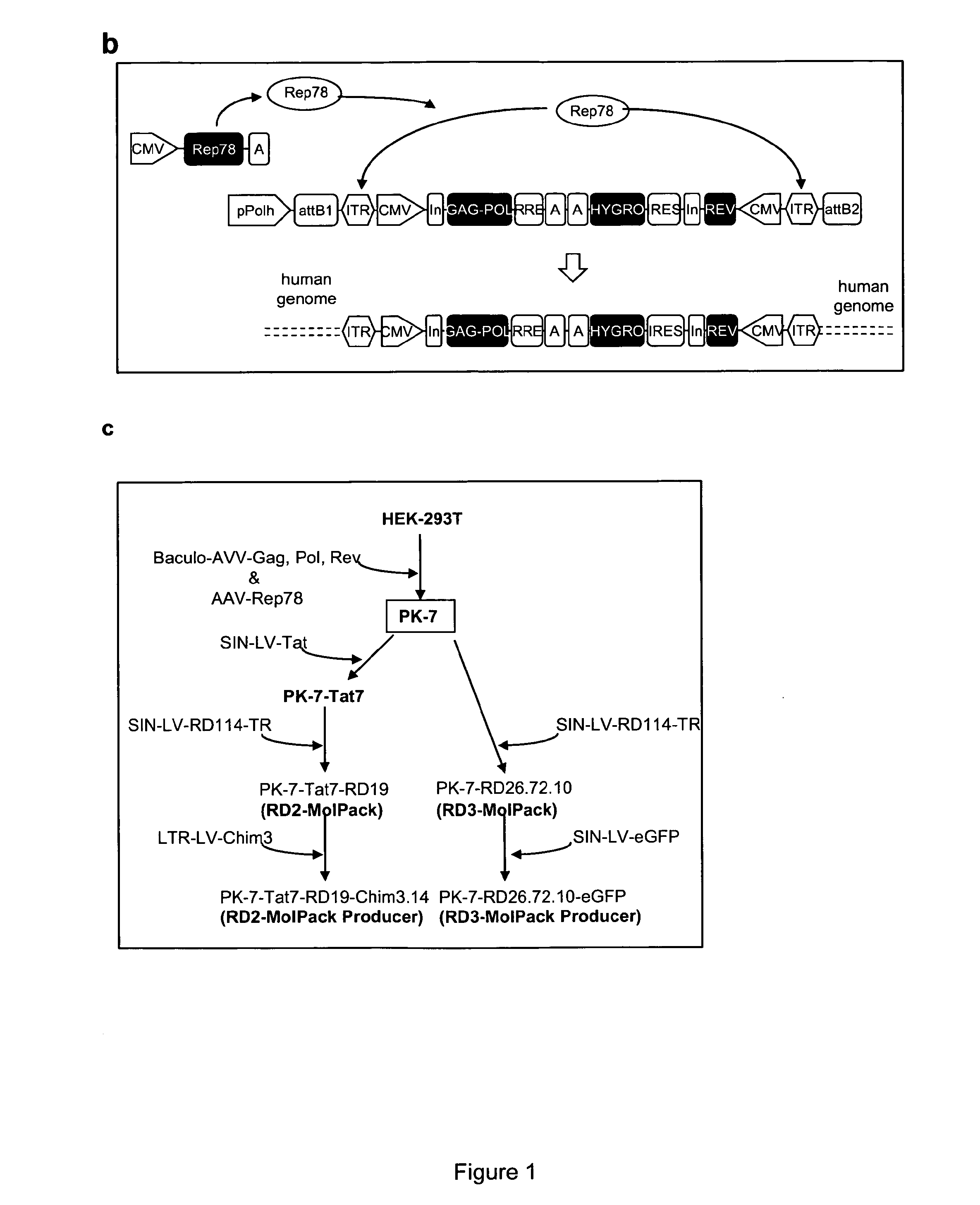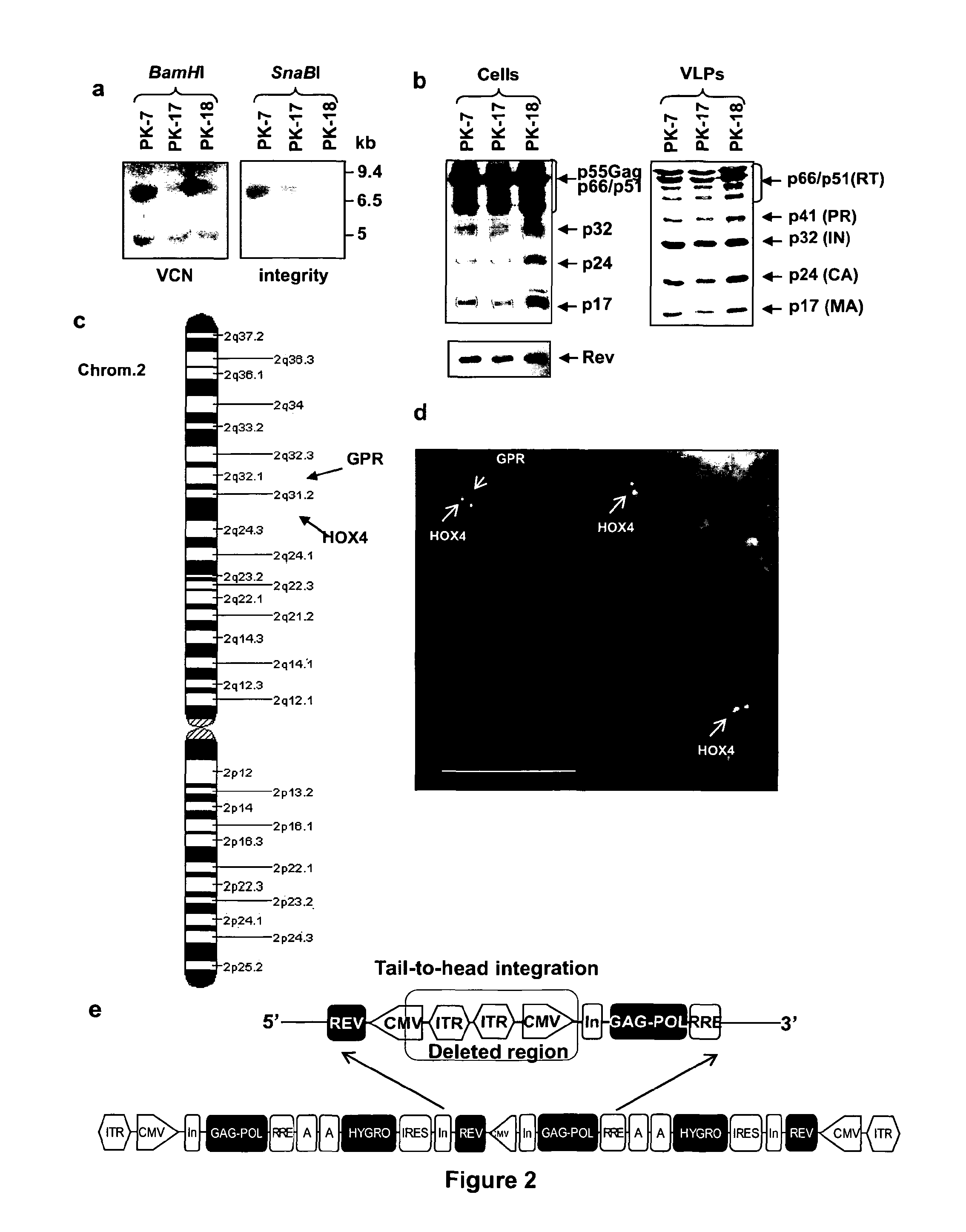Stable production of lentiviral vectors
a technology of lentiviral vectors and packaging cells, applied in vectors, viruses, medical preparations, etc., can solve the problems of difficult standardization and scaling up, high cost of technology, and inability to produce lentiviral vectors grounded in transient protocols, and achieve stably and effectively engineering host cells, facilitate genome integration of baculo-aav packaging vectors, and stable integration of structural hiv-1 proteins
- Summary
- Abstract
- Description
- Claims
- Application Information
AI Technical Summary
Benefits of technology
Problems solved by technology
Method used
Image
Examples
example i
General Methods
Plasmids
[0116]Wild-type HIV-1 gag, pol and rev genes were excised by MluI / NarI and MluI / NotI digestions from the pCG719-pKLgagpol (hereafter named CMV-GPR for simplicity) (FIG. 1a, scheme 13) and pCG720-pKrev (CMV-Rev) (FIG. 1a, scheme 9) plasmids, respectively [27]. The viral genes were inserted into the Gateway® pENTR™4 shuttle vector (Invitrogen, Co., Carlsbad, Calif.) in two distinct expression cassettes tail-to-tail oriented, each cassette driven by a CMV IE promoter and carrying a polyA sequence. The first cassette expresses the gag and pol genes whereas the second one the rev gene and the selection marker hygromycin resistance (hygro) gene; hygro was cloned downstream an IRES to allow bi-cistronic translation. The two expression units were introduced into the XbaI site of the recombinant pSUB201 plasmid carrying an infectious AAV genome [18]. The resulting 5′ITR-CMV-GagPol-polyA-polyA-hygro-IRES-Rev-CMV-ITR3′ cassette was then excised and inserted into the Gate...
example ii
Generation of the First Intermediate PK-7 Clone
[0134]To obtain the RD-MolPack packaging cell line for the continuous production of either 2nd- or 3rd-generation LV, several HEK293T-derived intermediate clones were developed. The first one was named PK-7 and was obtained by stable integration of HIV-1 gag, pol, and rev genes by means of the recombinant hybrid baculo-AAV vector (rhBaculo-AAV-GPR) (FIG. 1a, scheme 1). This delivery system exploits the integrase activity of AAV-rep78 protein, provided transiently, to excise and integrate the AAV ITR-flanked integration cassettes into human chromosomes (FIG. 1b). The rh-baculo-AAV vector was generated by homologous recombination between the BaculoDirect Linear DNA and the Gateway® pENTR™4 entry plasmid containing the ITR-flanked GPR cassettes (FIG. 1a, scheme 1). After 3 cycles (p3) of recombinant baculovirus amplification in Sf9 insect cells, the titer and the potential recombination events of the hybrid baculo-AAV DNA were checked by p...
example iii
Development of the Second Intermediate, PK-7-Tat7 Clone for 2nd Generation RD2-MolPack
[0141]The next step towards the development of the 2nd generation RD-MolPack (FIG. 1c) consisted in the stable integration of the HIV-1 regulatory factor Tat into PK-7 cells by means of SIN-LV delivery (FIG. 1, scheme 2). Cells were transduced by two cycles of spinoculation and then cloned by limiting dilution after puromycin selection. 11 growing clones were picked up and, after a first screening based on p24gag production, Tat expression was established by Western blot using nuclear extracts obtained from five clones showing ≧5 ng p24gag / 1×106 cells values. Only PK-7-Tat5 and PK-7-Tat7 clones displayed high level of tat (FIG. 3a) and p24gag (FIG. 3b). Thus only these two clones were further characterized establishing by TaqMan PCR that PK-7-Tat5 contains 12 and PK-7-Tat7 six tat gene copies; LV potency was also measured by co-transfecting the remaining VSV-G envelope plasmid and the PΔN-eGFP 2nd-...
PUM
| Property | Measurement | Unit |
|---|---|---|
| concentrations | aaaaa | aaaaa |
| temperature | aaaaa | aaaaa |
| concentration | aaaaa | aaaaa |
Abstract
Description
Claims
Application Information
 Login to View More
Login to View More - R&D
- Intellectual Property
- Life Sciences
- Materials
- Tech Scout
- Unparalleled Data Quality
- Higher Quality Content
- 60% Fewer Hallucinations
Browse by: Latest US Patents, China's latest patents, Technical Efficacy Thesaurus, Application Domain, Technology Topic, Popular Technical Reports.
© 2025 PatSnap. All rights reserved.Legal|Privacy policy|Modern Slavery Act Transparency Statement|Sitemap|About US| Contact US: help@patsnap.com



